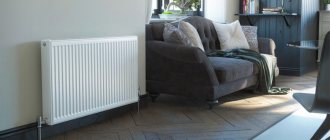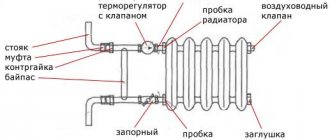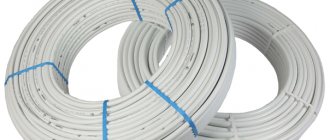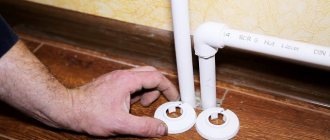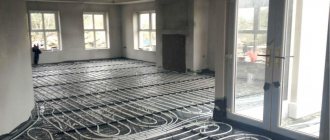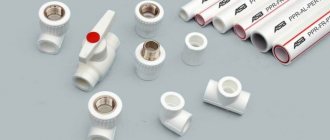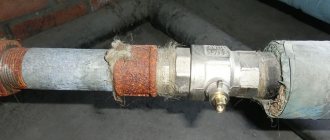Problem
The main problem that my relatives told me about was absolutely cold radiators in two adjacent rooms, while in other rooms the radiators got noticeably warmer with the beginning of the heating season.
- In rooms with warm batteries, the average daily temperature was + 17C;
- In rooms with inoperative heating + 13C.
As they say, feel the difference ...
For several days, calls from neighbors and relatives in the heating network ended in approximately the same way - nothing, because the house is cooperative, and its maintenance is not within their competence, except in emergencies.
And it was expensive for a cooperative of 60 apartments (4 entrances), where more than half of the residents are people of deep retirement age, to support their permanent plumbing from their own pockets. The part-time specialist only made sure that there were no leaks during system startup, and nothing more.
Searching of decisions
Arriving at the place, the first thing I do is check the taps on the radiators and bypasses - everything is open in both rooms. I open Mayevsky's taps on each radiator - a thin stream of water informs that there is pressure in the system, and the radiator is not air-conditioned. But you need to find out if there is a coolant in the system at all.
To this end, I go to the basement of the house. From the elevator unit I determine the direction and find "my" supply and return pipes.
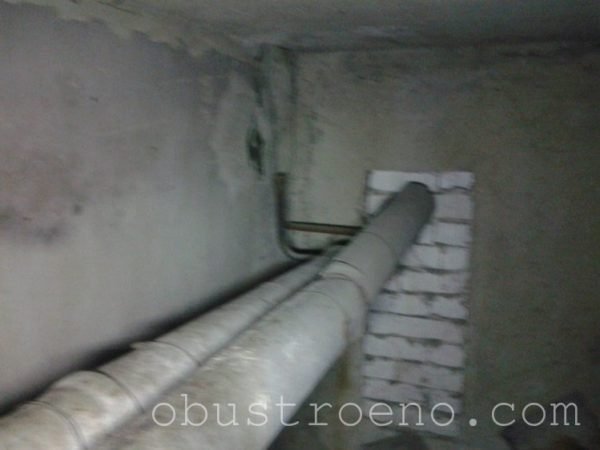
This is our highway.
Having reached the location of the apartments in our entrance, I see two pipes - supply and return. To the touch, both pipes differ quite noticeably, so it was not difficult to determine that the colder one is the return.
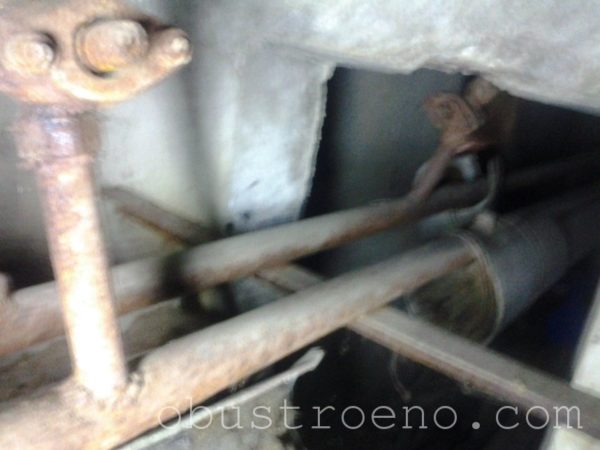

In the foreground is the return line.
Again I use my hands - both risers are cold, although literally a meter before this area the temperature was more than comfortable. The reason is the airing of the system on the upper fifth floor, which is why the coolant does not circulate.
I leave the basement and go to get acquainted with the neighbors of the upper floor, along the way asking other residents about the presence of stopcocks and their condition. As you'd expect, everyone has cast iron radiators installed 30 years ago.
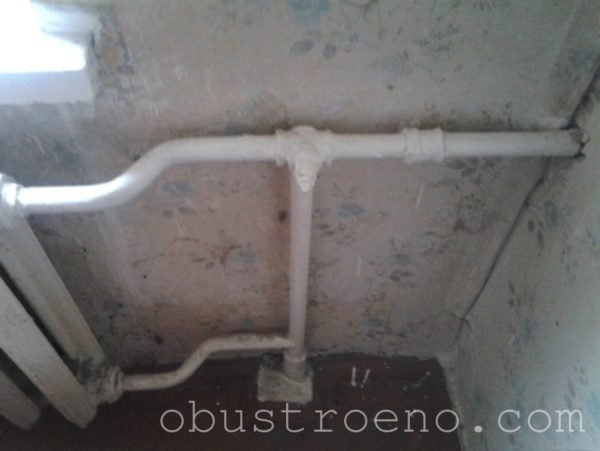

The fifth floor is a lintel between rooms.
In Khrushchev houses there is no technical floor, so the coolant is supplied from below from the basement. For clarity of the operation of the heating system, I propose to consider the diagram below.
Red arrows show the direction of movement from the feed, blue - the return.
We return to the apartment on the fifth floor. Cast iron radiators with 12 and 7 sections were installed in two rooms of the family of pensioners. It was them who were to be airy.
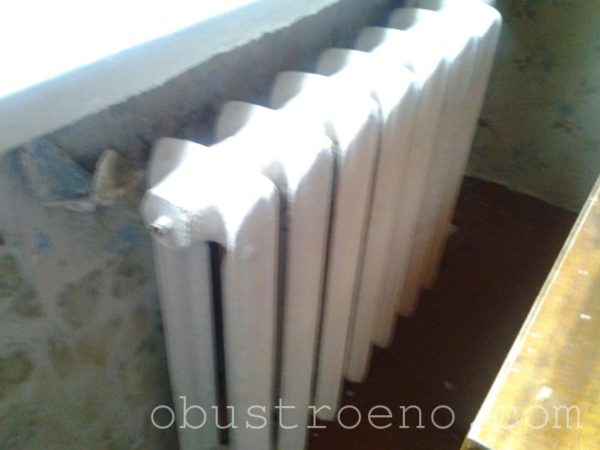

The reason for the lack of heat is in the accumulated air inside the radiator.
The only method available for this is with the help of a nipple (a prototype of the Mayevsky crane) embedded in the radiator cap.
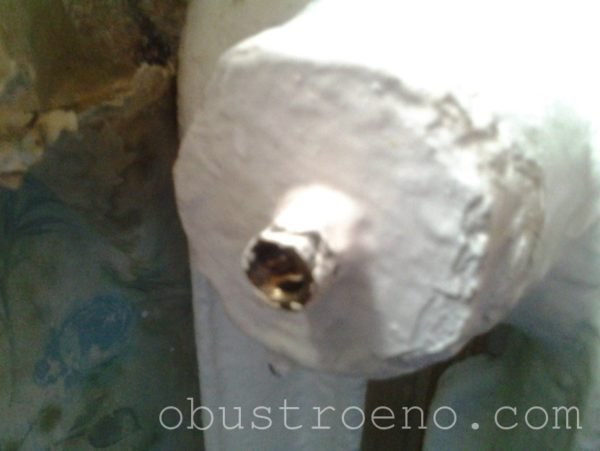

Upcoming place of work.
- Old galvanized bucket for 12 liters;
- Pliers;
- Two flat-blade screwdrivers;
- A few doormats - splashes are inevitable.
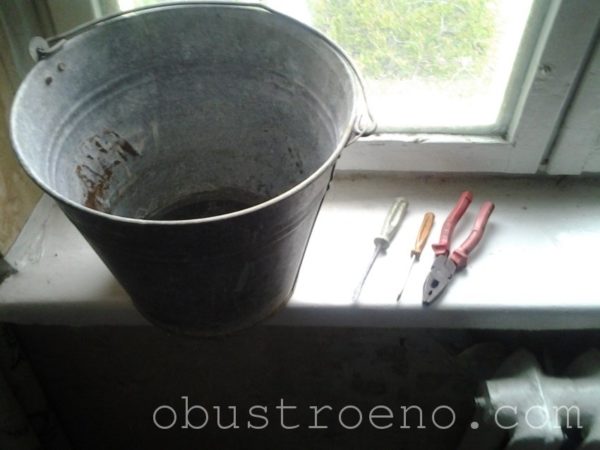

Here it is our simple tool.
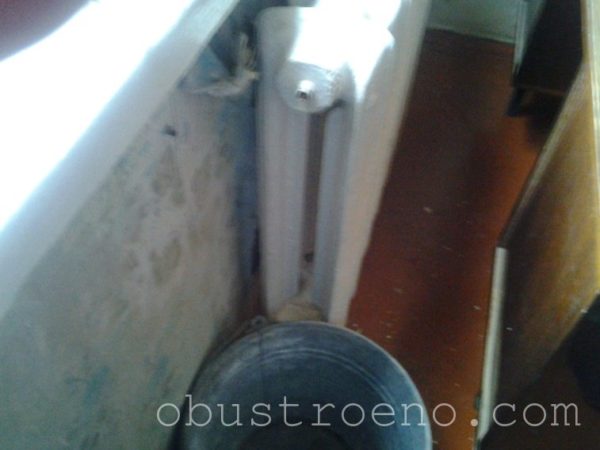

I install a bucket under the radiator.
Since a lot of splashing is expected, I provide a place around the radiator to work - I remove the flower pots and move the furniture away
Then I take a screwdriver and carefully, so as not to lick off the edges, unscrew the screw counterclockwise
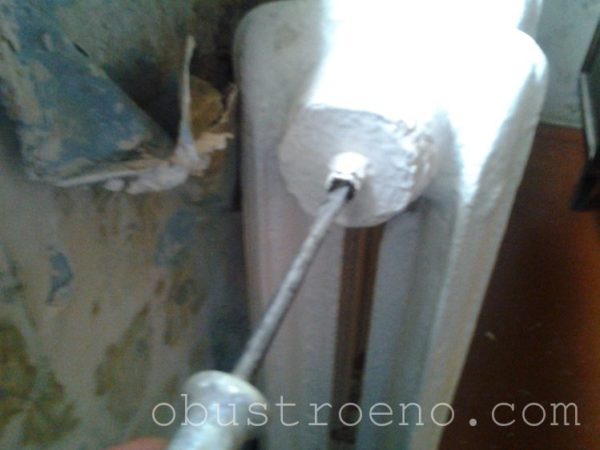

Excessive efforts have to be made.
- The old system did not give in on the first try, I had to use the pliers - with their help I turned the screwdriver until the screw moved off the stuck place;
- A hiss of air marked the beginning of an airlock. Within 3-4 minutes the air left the radiator, after which cold water flowed in a thin stream;
- By adjusting the screw so that water flowed into the bucket that was placed, I gave time - in about half an hour, when the bucket was half full, the temperature of the water changed from ice to warm, after which I screwed the screw back.
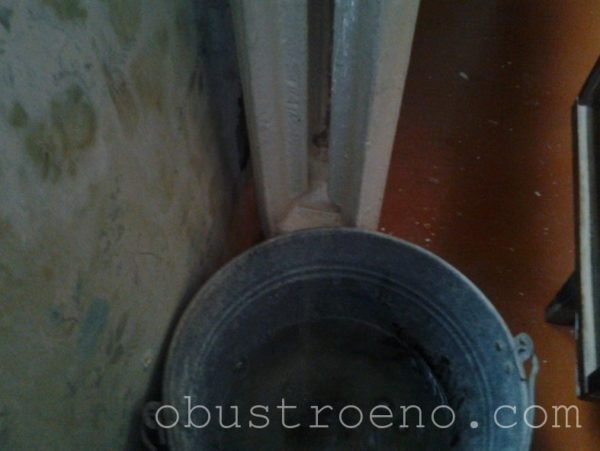

How not to remember the classics: "Oh, lukewarm went ...."
I did the same operation with a cast-iron battery in another room. A few hours later, it became noticeably warmer in the apartments - the thermometer showed a rise of a couple of degrees. Of course, there is no need to talk about a complete solution to the problem of cold in the apartment, because the temperature of the coolant is far from 75C, but outside the window is not yet a fierce winter.
I hope that my experience will be useful to some of you. If the symptoms are similar, negotiate with the neighbors of the upper floor and air the riser before winter sets in. Good luck comrades!
General information about panel radiators
The panel radiator belongs to the convective type of heaters, and the room is heated by air convection through the room. These radiators are often called convectors.
To enhance convection, they make only one panel, but also two and three panel ones. The radiator panels are interconnected by vertical pipes and protected by covers on all sides.
Manufacturers produce panels in different sizes. Typical panel heights are 300-900 mm, panel depths are from 60 to 160 mm.
The panels are distinguished by their low weight. Also, due to their design, they have low thermal inertia, that is, they quickly heat up and cool down quickly. As a result, they are easily controlled by automation and can be used in automatic room heating control systems.
The panels operate at a pressure of 6-8 atm, and the system is pressurized (checked), using them, at 13 atm.
But, like all panel radiators, they have their drawbacks.
How to hide heating pipes in the bathroom
The bathroom differs from all other rooms in high humidity. This will be the feature: you need to use materials that are not afraid of moisture. The solutions here are, in principle, the same: hide in the wall or make a box for them. Naturally, pipes must be laid in the wall before laying the tiles, but the box can be built after.
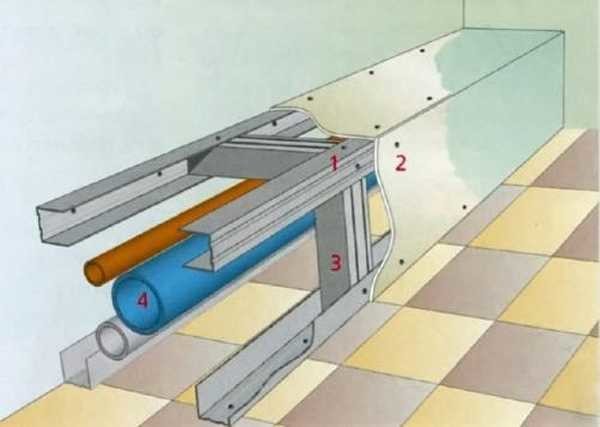

How to hide heating pipes in a bathroom
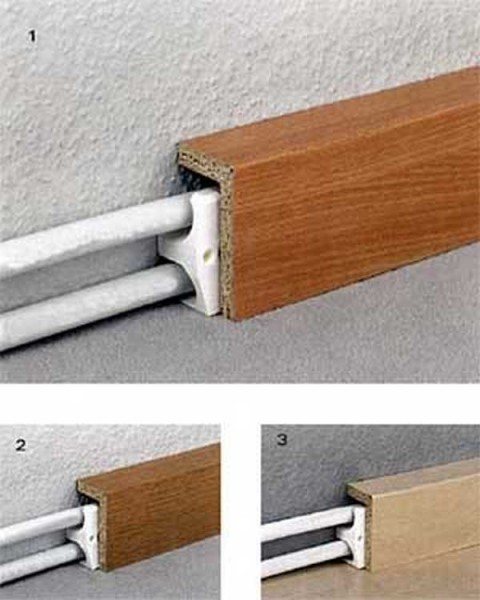

Hiding the heating pipes under the baseboard is one of the ways to get by with "little blood"
The principle of construction is no different: you make a frame, and then sheathe it. But the difference will be in the materials. You need to use galvanized profiles, and drywall is moisture resistant. Even taking into account the fact that you will stick the tiles on top. The tile will most likely have to be cut to fit the frame format (or the frame size should be made taking into account the tile size), and the corners and cuts can be closed with special corners to match the tile, contrasting color, white, etc. - the choice depends on your desire and bathroom design.
One of the panels of the box can be made removable. It can be held on magnets, corners, stops. This will not violate the aesthetics and will provide access to communications.
There is an option that, if appropriate, will allow you to get off with "little blood": there are special plastic baseboards-boxes. So if the heating pipes in a bathroom or another room run along the wall above the floor itself, you can hide them in such a baseboard.
If none of these methods suit you for some reason, you can try to decorate them.
The battery in the wall: how to get rid of it and is it worth it?
The main problem with such batteries is the inability to shut them off when it gets hot. Plus, houses are aging and the pipes in them naturally too. A rush can happen at any moment. And if in a building with "open" heating pipes, they can be replaced with new ones without tangible problems. Then with the "walled up" will have to work hard.
Moreover, in most cases, the first thing to do is to order a project for reorganizing the heating system, and go through a lot of approvals. Design and estimate documentation can be done on the side, and you will have to go to the housing office for approvals. It is best to entrust the work to them.
The principle of building a heating system
Speaking about the principle of operation of the heating scheme for multi-storey buildings, a few words should be said about its construction. It's actually pretty simple. Most modern homes use a one-pipe centralized heating system for a five-story house or one with fewer / more stories. That is, the heating scheme of a 5-storey building is a single (for one entrance) riser, in which the coolant can be supplied both from below and from above.
In accordance with the location of the supply element, there are also two types of directionality of the coolant. So, provided that the supply pipes are located in the basement, there is a counter movement of the coolant. And if the supply element is in the attic, then the passing direction.
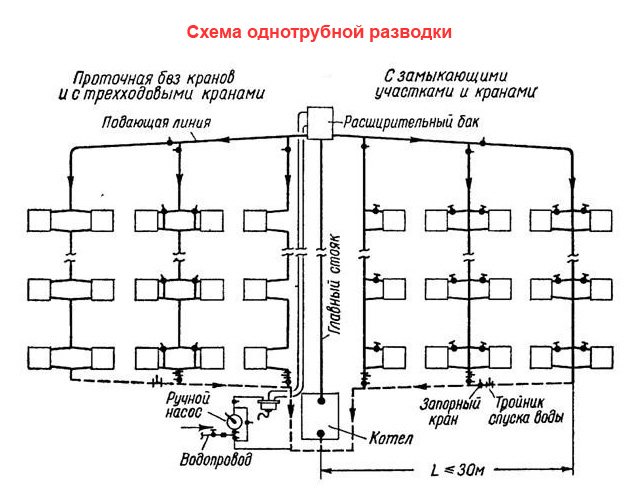

Many are interested in how the radiator area is determined for a particular room. In fact, everything is quite simple - you just need to take into account the cooling rate of the used coolant (water).
Most of us mistakenly believe that the higher the house, the more complicated and confusing is the heating scheme of a multi-storey building. But this is a wrong opinion. In fact, the number of apartments that need to be heated mainly affects the calculation of heating in an apartment building.
1. 2. 3. 4. 5.
An apartment in a multi-storey building is an urban alternative to private houses, and a very large number of people live in apartments. The popularity of city apartments is not strange, because they have everything that a person needs for a comfortable stay: heating, sewerage and hot water supply. And if the last two points do not need special introduction, then the heating scheme of a multi-storey building requires detailed consideration. From the point of view of design features, the centralized one has a number of differences from autonomous structures, which allows it to provide the house with thermal energy in the cold season.
The device of a centralized heating system and the principle of operation of its nodes in an apartment building
It is clear that in order to provide heat to an apartment building, it must be connected to a heating network coming from a boiler house or CHP. For these purposes, pipes leading to the building are installed inlet valves
from which one or two heating units are powered.
After the valves, as a rule, are installed mud collectors
, intended for the deposition of oxides and metal salts formed in the pipeline during prolonged contact with hot water. By the way, these devices allow you to extend the period of maintenance-free operation of the heating system.
Further in the house circuit are located hot water supply
: one on the flow, the second on the return. As you know, central heating operates on overheated water (the temperature of the heat carrier from the CHP is 130-150 ° C, and so that the liquid does not turn into steam, a pressure of 6-10 kgf is created in the system). Therefore, in the cold season, DHW is connected from the return, where the water temperature does not usually exceed 70 ° C. In the summer, when the temperature of the coolant in the heating network is relatively low, the hot water supply is connected from the supply.
After the DHW valves, the most important unit of the system is located - heating elevator
, the main purpose of which is to cool the superheated (coming from the CHP) water to the standard values required for supplying directly to the heating devices of an apartment building.
This device consists of a steel body, in which a nozzle is located, from which the water coming from the heat and power plant leaves at a reduced pressure and high speed. As a result of this, a vacuum is created, causing the coolant to leak from the return to the elevator, where the water is mixed, i.e. change in its temperature.
Figure 6 - Heating elevator device
It should be noted that the regulation of the heating system, i.e. determination of the real temperature difference in it, as well as the heating level of the working water mixture and, accordingly, heating devices, is carried out by changing the diameter of the elevator nozzle.
Usually located behind the elevator heating valves
entrances or an apartment building in general.
House valves allow you to connect and cut off the heating circuit of the building from the heating plant: in winter they are open, in summer they are closed.
Further, central heating provides for the installation of so-called discharges
, which are valves for bypassing or draining the system. Sometimes they are connected to the cold water supply pipeline in order to fill the radiators with water in the summer.
In recent years, in accordance with the requirements for the mandatory installation of metering devices, heat meters
.
Figure 7 - Diagram of the device of the heating unit of the central heating system
Risers and spouts of the centralized heating system
The scheme of organizing the circulation of water in the system of an apartment building is, as a rule, a one-pipe version of the supply of a coolant with an upper or lower filling. In this case, the supply and return pipes can be bred either both in the basement, or the supply in the attic or technical floor, and the return in the basement.
Risers, in turn, come with:
- passing movement of the coolant;
- the movement of water up and down;
- oncoming traffic from bottom to top.
Using bottom filling schemes
each pair of risers is connected by means of jumpers, which can be located either in apartments on the top floor or in the attic. In this case, an air vent (air vent) must be installed at the upper point of the bulkhead.
Mayevsky's crane is the simplest in design, but fail-safe air vent.
The main disadvantage of this option is the airing of the system after each water discharge, which requires bleeding air from each bulkhead.
Figure 8 - Possible schemes of the central heating system with bottom filling
Top-fill heating system
provides for the installation on the technical floor of a multi-storey building of an expansion tank with an air vent valve, as well as separate valves that allow you to cut off each riser.
The correct slope when laying the filling ensures that when the air vents are opened, the water is completely drained from the system in a very short time. But this option has a number of features that must be taken into account when designing.
- The temperature of the heaters decreases as the heating medium moves downward. It is clear that on the lower floors it will be much lower than on the upper ones, which is usually compensated by an increase in the number of radiator sections or convector area.
- The heating start-up process is quite simple. This requires filling the system, opening the existing house valves and for a short time the air vent on the expansion tank. After that, the central heating and the entire system are fully functional.
How to hide heating pipes in a private house by decorating
Hiding pipes in a wall or box significantly reduces the heat transfer of heating elements. Sometimes these activities are contraindicated.That is why pipe decor is widely used to close communications.
In this version, you can safely listen to your imagination. The main thing is that the original effect fits harmoniously into the interior of the room. You can simply paint the pipes to match the color scheme of the room.
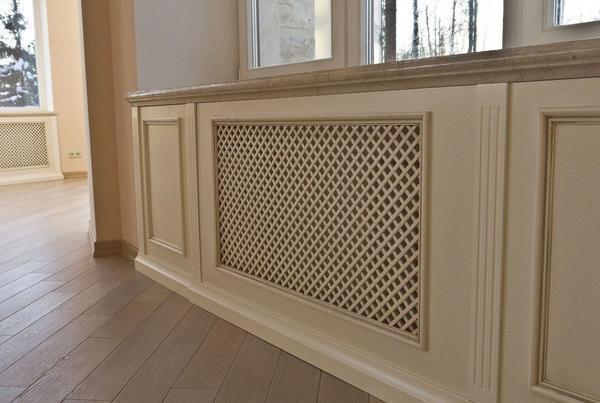

Requirements for paints:
- Mechanical durability;
- Thermal strength;
- Non-toxic.
Jute or hemp rope can be used as a decor. But this will reduce the heat transfer of the pipes. You can also try split bamboo. You can additionally decorate with branches and leaves, creating a branch. Highly placed pipes can be closed with curtains.
For staining communications, water-dispersion, acrylic or alkyd enamel is used.
It is easier to hide pipes at the stage of laying communications. Then it becomes possible to mount the system as discreetly as possible. Also, in this case, it becomes possible to make a warm floor.
How to hide heating pipes in an apartment using a box
The box is considered a good option when the heating system is already installed. You can sheathe the casing with plastic, drywall, wood. Before work, you should make sure the integrity of communications.
Required tools for installation:
- Metal profile;
- Self-tapping screws with dowels;
- Material for the box;
- Screwdriver;
- Drill;
- Scissors for metal.
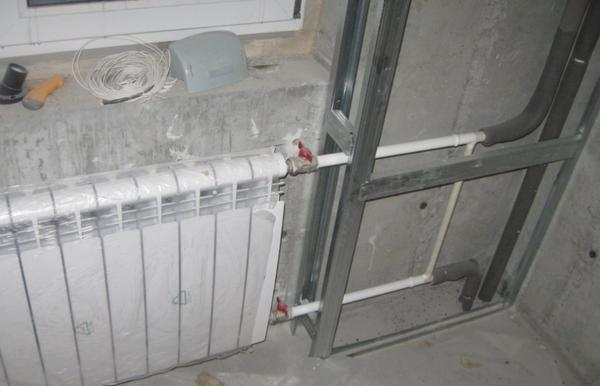

First you need to make the frame of the box. The material of manufacture is fixed with self-tapping screws. First, they mark up the location of the communications. Take into account the dimensions of the pipes, the thickness of the material and the interval between the walls of the box and communications.
Do not install pipes close to the box. It is optimal to leave a distance of 3 cm.
Further building profiles are installed. Then the guides are fixed. To fasten the profiles together, cutters are used.
Then the corner profiles are mounted. If the spacing between the posts exceeds 25 cm, then additional jumpers should be made. If the height of the racks is more than 150 cm, then horizontal jumpers are mounted. When the frame is ready, they begin to design it. Bevels are removed from drywall before installation. But if in the future tiling is envisaged, then this process can be omitted.
They begin to install the walls of the box from the side parts and move towards the central ones. After installing the walls, the box must be decorated decoratively. To do this, use tiles, wallpaper, paint.
If you want to hide the batteries, you can build a false wall. The execution technology is similar to the box. First, the frame is made, then the walls are sheathed. A significant disadvantage of this decoration method is the reduction in the area of the room. If you don't want to bother with installing these elements, then you can purchase a ready-made box in a hardware store.
Initial treatment of the wall behind the battery
In the picture above, you can clearly see that the wall behind the battery has not been processed. If this is the first time you remove the battery, then most likely there will be not a white, but a gray dusty wall with old stubborn paint. It is clear that you cannot immediately glue the wallpaper on such a wall. If you decided not to glue the wallpaper, but to make the wall cladding a decorative panel, as can be clearly seen in the pictures in the article, then in any case, the wall needs to be processed at least in order to remove the smells of old walls and old repairs (advice from my personal experience ).
So where do you start? We begin to beat off the extra bumps on the wall, the remnants of old putty and paint with a hammer and chisel. Especially we pass in those places where the plinth should be attached to us. Planned time about 1 hour:
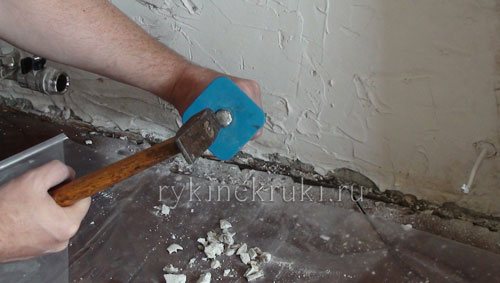

Then it is imperative to remove all debris and prime the wall (see section).
We prime the wall 2 times. The priming itself takes 10 minutes, but the drying time for each of the layers is 1.5 hours.
Total: cleaning + wall priming + drying time is about 4 hours.
Design features of the heating circuit
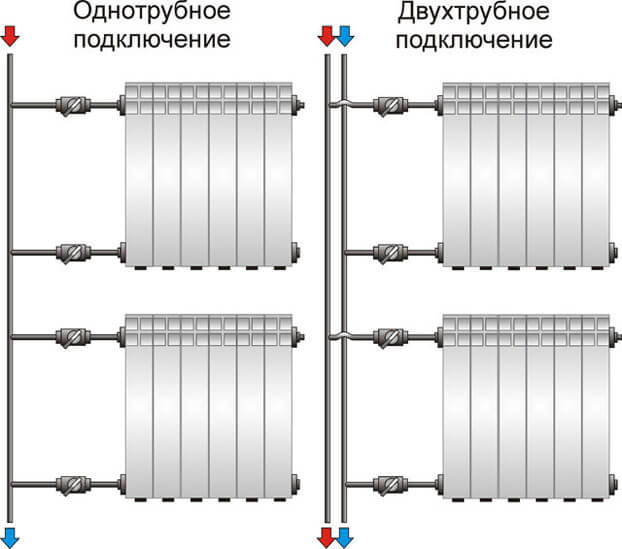

In modern buildings, additional elements are often used, such as collectors, heat meters for batteries and other equipment. In recent years, almost every heating system in high-rise buildings has been equipped with automation in order to minimize human intervention in the work of the structure (read: "Weather-dependent automation of heating systems - about automation and controllers for boilers by examples"). All the details described allow you to achieve better performance, increase efficiency and make it possible to more evenly distribute heat energy across all apartments.
Heating scheme for a multi-storey building
Owning an apartment in the city is a luxury item. It is also comfort and coziness for its owners, since a city apartment is the most common place for living among modern citizens. It should be noted that a good heating system plays an important role in creating a comfortable environment in such an apartment. The heating circuit of a multi-storey building is a very important detail for any person.
In modern life, such a scheme has many design differences from conventional heating methods. Therefore, heating schemes for a three-story house and more guarantee effective heating of the walls even in the most unpredictable weather.
Features of heating an apartment in a multi-storey building
Having carefully read the instructions for the heating scheme for a multi-storey building, you can make sure that all norms and requirements must be followed without fail.
Any apartment should have adequate heating, which raises the air temperature to 22 degrees and keeps the humidity in the room within 40%.
The scheme of the heating system of an apartment building provides for its competent installation, due to which it is possible to achieve such a temperature and humidity.
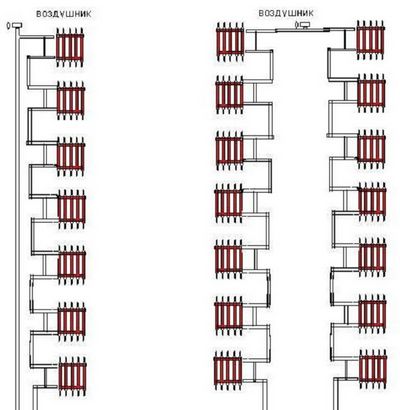

In the process of designing such a heating scheme, highly qualified specialists should be invited who can qualitatively calculate all the necessary aspects for work. They must ensure that uniform pressure of the coolant is maintained in the pipes. This pressure should be the same on both the first and the last floor.
The main feature of a modern multi-storey building heating system is manifested in the work on overheated water. This coolant comes from the CHP and has a very high temperature - 150C with a pressure of up to 10 atmospheres. Steam is generated in the pipes due to the fact that the pressure in them rises greatly, which also contributes to the transfer of heated water to the last houses of the high-rise building. Also, the heating scheme of a panel house assumes a considerable return temperature of 70C. In warm and cold seasons, the water temperature can vary greatly, so the exact values will depend solely on the characteristics of the environment.
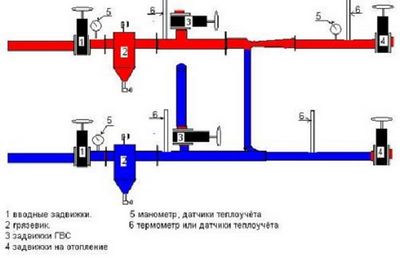

As you know, the temperature of the coolant in the pipes, which are installed in a multi-storey building, reaches 130C. But such hot batteries in modern apartments simply do not exist, and this is due to the fact that there is a supply line through which heated water passes, and the line is connected to the return line using a special jumper called an "elevator unit".
Battery replacement options
- The batteries with pipes are built into the façade walls.
Most likely, any work in this case will be strictly prohibited. Indeed, the design of the building includes heat from these pipes along the facade. And any individual changes are simply unacceptable. The only solution would be to order an alteration of the heating system throughout the house with insulation of the outer walls. It will be necessary to break through the floors, equip the risers and only then connect new radiators to them.
- Piping in inner plates.
There are serious restrictions on load-bearing walls. As a rule, it was in them that the batteries were embedded. And any demolitions or penetrations are not allowed.The only thing that can be done is to find “embedded” in the corners of the slabs. These are such pockets in concrete, where the slabs and heating pipes were connected to each other. These places are easy to find by tapping. After connecting the pipes, the voids were filled with a solution that sounds very different from factory concrete. Then the coil in the wall is tightly closed and a new radiator with a bypass is inserted.
- The batteries are inside, but there are riser bends outside.
In some series of houses, although the radiators are also in the walls, bends of pipes can be seen in the corners of the rooms. Everything is much simpler here. Getting close to them and crashing into the system will not be difficult. In addition, you do not have to make a project and go through lengthy approvals.
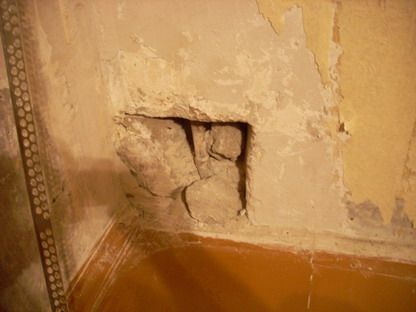

Whatever the situation, you need to clearly understand that the battery embedded in the wall is in fact the common riser of the entire entrance. And any changes on it affect the quality of heating for all neighbors above and below. Whatever is done, the riser must not be blocked or narrowed.
Only a specialist can accurately determine the series of the house and the configuration of the pipes inside the panels. It will be necessary to bring up the documents of Soviet projects. On your own it will only be possible to find approximately by touch where such a battery is located.
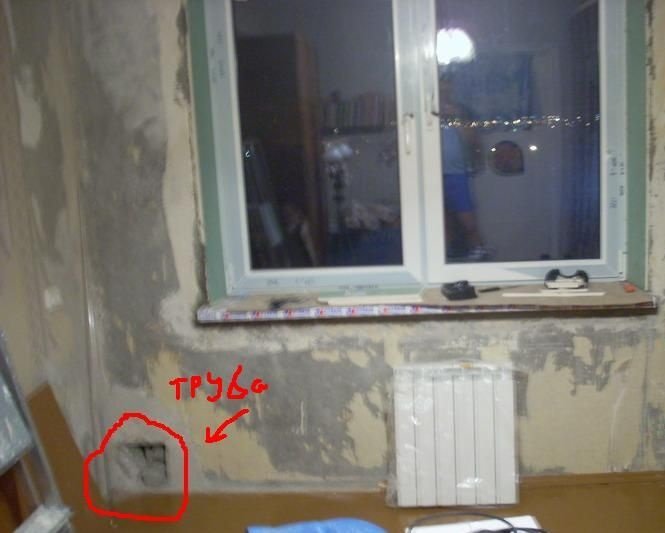

All these works will cost a lot of money. And heat problems can be completely different.
Before "removing" the batteries from the walls, it is worth contacting the house management company and demanding to identify the reasons for the lack of heat in the rooms. Perhaps an air lock has simply formed in the embedded pipes or there are defects in the sealing of the seams. Or from time to time the insulation inside the panels simply decayed. In many cases, they will fix problems without reworking the heating system, or will be forced to install an external battery for free.
Replacement, transfer and selection of radiators in an apartment building
We will make a reservation that any changes to apartment heating in an apartment building must be coordinated with the executive authorities and operating organizations.
We have already mentioned that the principal possibility of replacing and transferring radiators is due to the circuit. How to choose the right radiator for an apartment building? Consider the following:
- First of all, the radiator must withstand the pressure, which is higher in an apartment building than in a private one. The larger the number of floors, the higher the test pressure can be, it can reach 10 atm, and even 15 atm in high-rise buildings. Contact your local operator for the exact value. Not all radiators on the market have the appropriate characteristics. A significant part of aluminum and many steel radiators are not suitable for an apartment building.
- Whether it is possible and to what extent to change the thermal power of the radiator depends on the applied circuit. But in any case, the heat transfer of the device must be calculated. In one typical section of a cast-iron battery, the heat transfer is 0.16 kW at a coolant temperature of 85 ºС. Multiplying the number of sections by this value, we get the thermal power of the existing battery. The characteristics of the new heater can be found in its technical data sheet. Panel radiators are not recruited from sections; they have fixed dimensions and power.
The average heat transfer data for different types of radiators may vary depending on the specific model.
- The material also matters. Central heating in an apartment building is often characterized by a low quality of the heating medium. Traditional cast-iron batteries are the least sensitive to pollution, and aluminum ones react the least to an aggressive environment. Bimetallic radiators have shown themselves well.
Heating system wiring diagram
When placing heating devices inside a room or during repair work, the question often arises about the pipe layout.Standard schemes: beech P or inverted beech W. Which of their schemes is implemented in your apartment depends on the panel house.
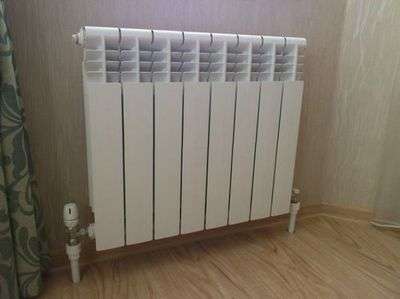

Two risers are located next to each other. Sometimes they are separated by a wall that separates the rooms. In this case, the riser looks like a letter T, 2 risers are located on one side and one on the other. They pass through the walls. Conclusion of zones of connection of structures - ceiling and floor.
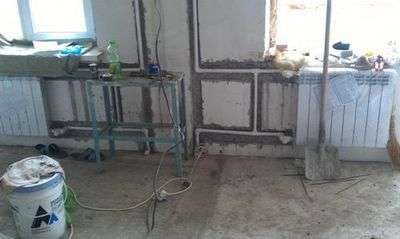

Wall-mounted heating pipes are usually made of metal. The advantages of this material are durability and reliability. In addition, during repair work using a hammer drill, you do not have to worry that the drill will damage the structure. When in contact with metal, you will quickly be able to understand that in this place you need to stop work.
Pros and cons
Rejoicing or preparing for the harsh winter period if you have moved to a panel house with heating pipes embedded in the wall? Let's consider the pros and cons of this option. Among the main advantages, it should be noted:
- Aesthetics. Structures taken inside often spoil the general appearance of the apartment. The system inside the partition allows you to keep the design of the room without this "eyesore";
- Saving space. This factor is especially relevant for small apartments. Heating elements do not take up free space, which is already small;
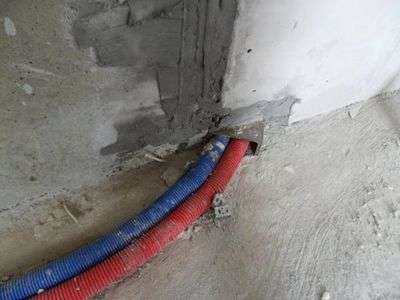

Efficiency. Do not be afraid that all the heat will go into the partition. Heating elements in such structures are designed for high power, which is enough for high-quality heating of the room. In addition, to increase the efficiency of the system, constructions with verified diameters are used and the most suitable wiring diagram is applied.
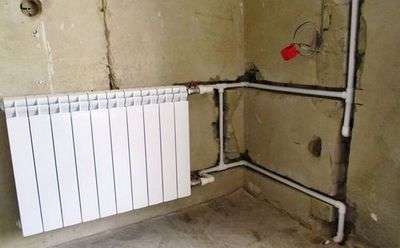

However, heating pipes in the wall also have disadvantages:
- In some cases, low power. The capacity of the system is highly dependent on the service provider. Sometimes there is not enough heat from the heating elements;
- Difficulties with the repair work. In the event of an emergency, it will be difficult to get to the structure. However, such contingencies are very rare;
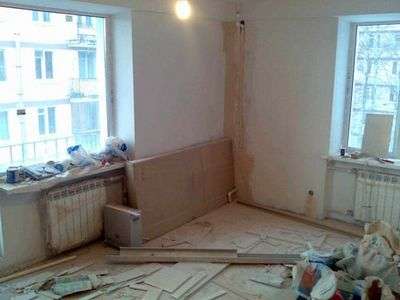

Partition problems
If you want to drill a partition, you need to do this with great care so as not to hurt the structure. To do this, first of all, you need to study the wiring diagram in your house; Difficulties with carrying out cosmetic repairs in the apartment
Hot structures can cause the plaster to crack. Wallpaper may also come off.
It is difficult to say for sure how effective and convenient the heating pipes in the wall will be. It all depends on the personal preference of the person. Some want to bring the heating pipes inside the room, while others, on the contrary, want to wed them into the wall. But, in any case, it should be remembered that work with risers must first be discussed with the relevant services. Unauthorized interference in the design scheme can entail a considerable fine.
Pipes will never add sophistication to a design
Even the most sophisticated design can easily ruin open heating pipes on the walls. They disharmonize on their own, and if the highways also intersect, then the room becomes like a utility room or technical room. You can avoid this situation if you think about how to hide the heating pipes from outside view in time.
Types of heating systems in apartment buildings
Depending on the structure, characteristics of the coolant and piping layouts, the heating of an apartment building is divided into the following types:
By location of the heat source
- An apartment heating system, in which a gas boiler is installed in a kitchen or a separate room. Some inconveniences and investments in equipment are more than offset by the ability to turn on and regulate heating at your own discretion, as well as low operating costs due to the absence of losses in heating mains. If you have your own boiler, there are practically no restrictions on the reconstruction of the system. If, for example, the owners want to replace the batteries with warm water floors, there are no technical obstacles to this.
- Individual heating, in which its own boiler room serves one house or residential complex.Such solutions are found both in the old housing stock (stoking rooms) and in the new elite housing, where the community of residents decides for itself when to start the heating season.
- Central heating in an apartment building is most common in typical housing.
The central heating device of an apartment building, heat transfer from the CHP is carried out through the local heating point.
According to the characteristics of the coolant
- Water heating, water is used as a heat carrier. In modern housing with apartment or individual heating, there are economical low-temperature (low-potential) systems, where the temperature of the coolant does not exceed 65 ºС. But in most cases and in all typical houses, the coolant has a design temperature in the range of 85-105 ºС.
- Steam heating of an apartment in an apartment building (water vapor circulates in the system) has a number of significant drawbacks, it has not been used in new buildings for a long time, the old housing stock is widely transferred to water systems.
According to the wiring diagram
Basic heating schemes in apartment buildings:
- Single-pipe - both the supply and return of the coolant to the heating devices are carried out along one line. Such a system is found in the "Stalinkas" and "Khrushchevs". It has a serious drawback: the radiators are located in series and due to the cooling of the coolant in them, the heating temperature of the batteries drops as they move away from the heating point. In order to preserve heat transfer, the number of sections increases in the direction of movement of the coolant. In a clean one-pipe system, it is not possible to install control devices. It is not recommended to change the configuration of pipes, install radiators of a different type and size, otherwise the operation of the system may be seriously disrupted.
- "Leningradka" is an improved version of a one-pipe system, which, due to the connection of heating devices through a bypass, reduces their mutual influence. You can install regulating (not automatic) devices on radiators, replace the radiator with a different type, but of a similar capacity and power.
- The two-pipe heating scheme of an apartment building began to be widely used in "brezhnevka" buildings, and is popular to this day. The supply and return lines are separated in it, so the coolant at the entrances to all apartments and radiators has almost the same temperature, replacing radiators with a different type and even volume does not significantly affect the operation of other devices. Control devices can be installed on batteries, including automatic ones.
On the left - an improved version of the one-pipe scheme (analogue of the "Leningrad"), on the right - a two-pipe version. The latter provides more comfortable conditions, accurate regulation and gives wider possibilities for replacing the radiator.
- The beam scheme is used in modern atypical housing. The devices are connected in parallel, their mutual influence is minimal. The routing is usually carried out in the floor, which allows the walls to be free of pipes. When installing control devices, including automatic ones, accurate dosing of the amount of heat in the premises is ensured. Technically, both partial and complete replacement of the heating system in an apartment building with a beam pattern within an apartment is possible, with a significant change in its configuration.
With a beam scheme, the supply and return lines enter the apartment, and the wiring is carried out in parallel with separate circuits through the collector. Pipes, as a rule, are placed in the floor, radiators are neatly and discreetly connected from below
Methods for installing heating in the walls of the room
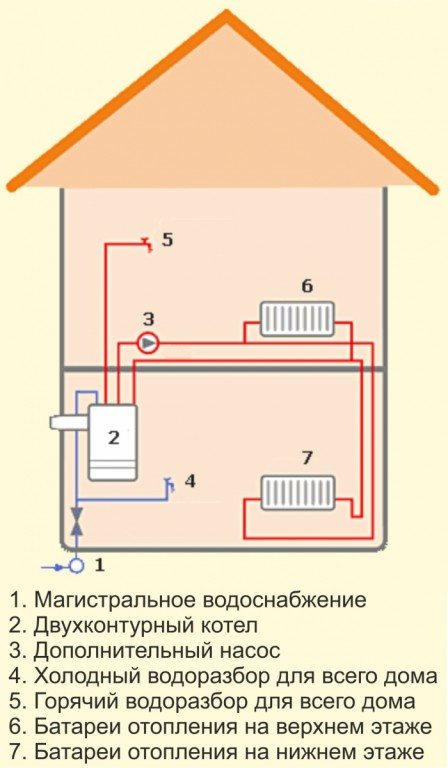

Direct piping scheme for a double-circuit gas boiler.
- Wall-mounted piping circuits or warm water walls are connected to a common hydraulic heating system for the entire apartment or house.
- Cable heating systems are used as an addition to the main heating system, electrical or cable.They represent a heating cable that is attached to the wall in the form of mats or along a certain path, has an autonomous connection to the network.
- Warm infrared walls are rod or film mats that are attached to the wall and connected in parallel. Typically, such heating in the wall is used as additional to the main heating system.
Where is the best place to locate a wall heating system:
- on the coldest wall of a room or in a corner room;
- the space in the room in front of such a system should not be cluttered with furniture or hung with carpets.
Wall systems are operated in a temperature regime not higher than 35-40 degrees, it is this temperature level that is considered the most comfortable for the human body. To maintain this optimum temperature, additional wall insulation is required to keep heat loss from the room to a minimum.
Installation of heating equipment using plaster coating:
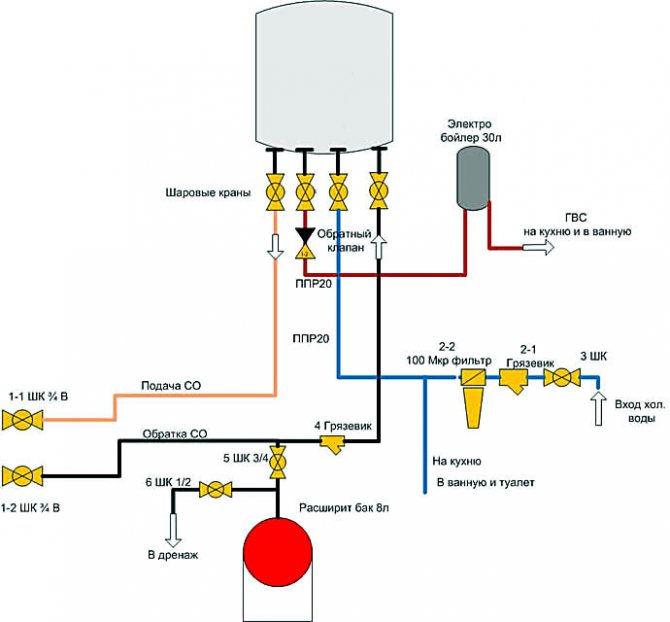

Scheme of piping a double-circuit boiler with a storage boiler.
- To do this, you need to prepare the wall, clean it, place the wiring and electrical boxes.
- Install the heat mixing unit.
- Glue polystyrene foam plates on the wall, and on top of them make a vapor barrier or use foil insulation (for example, penofol).
- Fasten the mounting rails to the wall to accommodate the piping. If warm walls are installed in the bathroom, then the heating system can be brought outside the wall surface and used as a heated towel rail.
- Place a serpentine pipeline along the wall, bypassing those areas where the furniture will stand.
- Connect the pipes to the heat mixing unit through the manifolds.
- Press pipes 1.5 times more than the working pressure.
- Fasten the reinforcing mesh.
- Cover the wall with a thin layer of gypsum plaster.
- Fix the temperature sensor under the top layer of plaster.
- As soon as the first layer of plaster is dry, apply the second one immediately. So that the layer does not crack and does not interfere with heat transfer, the second layer is made of lime-cement and above the pipes its thickness reaches 3 cm.
- To avoid the formation of cracks when heated, reinforcement should be made in the form of a thin mesh over the plaster under the putty.
Installation of heating equipment using a bezel:
- Attach a heat-insulating material to the cleaned wall - foamed foamed foam or expanded polystyrene.
- For the installation of pipes, reinforce the tires.
- Place the pipeline along the wall, connect it to the manifold cabinet.
- Install a metal frame or already assembled from bars.
- Finally, attach prepared boards or panels made of plasterboard, plastic or fiberboard to the frame.
Auxiliary heating in Khrushchev
What to do if, even after performing the improvement and replacing the elements, the temperature in the apartment is far from ideal. The best option is autonomous heating in Khrushchev. However, this is not always possible - the installation of a gas boiler is not allowed due to low pressure in the line or due to inappropriate chimney ducts.
Then they begin to develop alternative ways to increase the temperature in the room. The negative point is that the heating scheme of the five-story Khrushchev house does not provide for the connection of additional radiators. This can lead to a decrease in pressure in the pipes and significant heat loss for residents below. In order to avoid unpleasant moments, you can perform a number of actions that contribute to energy saving in the apartment.
Insulation of the outer walls of the Khrushchev
It is recommended to install a thermal insulation layer on the outer walls. It will help to reduce heat losses and will not affect the current state of the heating system in Khrushchev. It is also necessary to replace old wooden windows with new ones made of PVC or laminated veneer lumber. Particular attention should be paid to the thickness of the glass units.For effective thermal insulation, this parameter should be at least 28 mm.
Warm floor in Khrushchev
This is one of the best mechanisms for raising the temperature in an apartment. It can be installed not only in the bathroom and kitchen, but also in living quarters. It is best to choose infrared floor heating models, since their installation requires a minimum increase in the thickness of the floor covering. The heating circuit of the Khrushchev is not designed for connecting a water-heated floor. Its installation can lead to malfunctioning of the entire heating circuit of the house.
Heaters for apartments
They can solve the problem with the speed of heating the air in the apartment and do not affect the operation of the main heating system of the apartments in Khrushchev. Along with traditional oil and converter-type electric heaters, infrared models have become very popular. They raise the temperature not of the air, but of objects, heating their surface. However, the disadvantage of such devices is the increase in financial costs for electricity.
Before connecting the heaters, it is necessary to check the wiring. Often the cross-section of the wire is not designed for heavy loads. The heating scheme for a five-story Khrushchev is designed only for a water heat carrier. Therefore, it is first recommended to replace it, only then install powerful electrical appliances.
Wall decoration behind the radiators. Think about the little things
It turns out that when people make repairs in their apartments, they completely forget that the decoration of the walls behind the radiators is just as important as the decoration of the main walls. And after finishing the work, they realize that the batteries, in fact, are not completed, the wall behind them is ugly, and of course it needs to be brought into the appropriate form.
Why is this happening? Here are some reasons:
- the heating battery covers a part of the wall, so there is no need to do something behind it;
- there will be long curtains from the eaves to the floor and the batteries will not be visible at all;
- decorative screens will be hung on the batteries.
It is difficult to disagree with these points, since they are absolutely fair. But, not every family is able to plan all future repairs, as they say, on a turnkey basis, and many little things are thought out along the way. For example, after the completion of the repair, it turns out:
- probably in this room with such wallpaper, blinds are better, or short curtains to the windowsill, and not to the floor;
- the room is relatively small in area, and if you hang decorative screens on batteries, they will look very cumbersome and steal space in the room.
So it turns out that the primary vision regarding batteries has changed. It turns out that there will be no long curtains or decorative screens. So what then? A terrible, untreated wall behind the radiators, which, in the absence of curtains, is even very visible? By the way, there are houses where there are 2 windows in the rooms. So 2 scary walls will be visible?
What is the difficulty, you ask? Just think of a small piece of a wall, it can be done in a couple of days. However, this is an erroneous, at first glance, opinion. If the wall behind the batteries is really crooked or with potholes, then you can't just stick the wallpaper on it, most likely it will have to be leveled at the very least, which means you have to fiddle with the primer, and with plaster, and with putty. Read my detailed article about. After gluing the wallpaper, you must not forget to cut out and, which under the batteries are solid external and internal corners. The worst thing is that if your major repairs have already been completed, then the apartment is relatively clean. And just imagine, in a mini-version you actually have to repeat the entire repair from start to finish with a small piece of the wall.
True, I can reassure you a little, because there are certain assumptions that will still allow you to reduce the time. So let's get started. In parallel, I will take into account the time spent on such repairs.
How to insulate an apartment yourself
- In to all home heat, cold only in several apartments. Can whether outside insulate only them, but not to wait overhaul or thermal modernization?
This happens due to a defect in individual panels of the house. Based on the appeal of citizens and the subsequent examination of the apartment by representatives of the housing service and the design organization, the apartment can be insulated. Warming is carried out free of charge. If a person wants to insulate the plates of his apartment on his own, one square meter will cost him 80 thousand rubles.
- How much effective appliances individual accounting heat? Can whether them put in old houses?
Since 2003, heating systems with individual heat energy metering have been installed in new residential buildings. If you follow the guidelines, during the heating season, depending on the size of the apartment, you can save up to 200 thousand rubles on heating.
It is impossible to put individual heat metering devices on the existing heating system of the house without its reconstruction. But neither with major repairs, nor with thermal modernization of houses, the reconstruction of the heating system is not carried out.
- IN panel home cold, need to his warming. They say, queue. It is impossible whether wedge in in her, but not to wait some years?
Thermal renovation of a house depends on many factors: financing, plans and… sequence. That is, the first to be modernized will be those houses, the tenants of which previously submitted an application. At the same time, these issues should not be dragged out for years.
- Can whether withdraw battery of walls panel at home?
Battery withdrawal refers to the redevelopment and redevelopment of apartments, and therefore is regulated by the Regulation on the procedure for reorganization and redevelopment of residential premises in multi-apartment residential buildings. Such work should be carried out with the permission of the district administration according to the agreed project. The exact order can be found in the "One Window" service of the administration or in the HREO. The main stages of rebuilding the heating system are as follows: finding a design organization, developing a project and its approval, concluding an agreement with technical supervision, an organization that will carry out these repairs. The conclusion of the batteries ends with the acceptance of the work by the housing organization.
In the heating season, no one will be involved in the removal of batteries. But you can start preparing even today. Despite the fact that all the work can be done in a couple of days, the development of a project and its approval can take several months.
Officially
- At present, almost all residential buildings with 20 or more apartments are equipped with group metering devices for heat energy and automatic control systems, - says deputy minister housing—communal farms Nikolay Linden... - This allows you to automatically maintain the required temperature in living quarters - from 18 to 24 degrees. In case of deviation from these requirements, each citizen has the right to contact housing organizations, which must examine and take measures for adjustment and adjustment, to ensure the temperature regime both in a residential building and in a separate apartment.
According to the Deputy Minister of Housing and Communal Services Nikolai Lipen, there should be no misunderstanding between the residents of the house and the employees of the housing department:
- It is the duty of the housing organization that serves the house - to provide housing and communal services, to take measures to normalize the situation. What measures is another question. At least in every apartment the minimum temperature must be ensured. The parties must find a common language. If they do not find it, then today the Law "On Protection of the Rights of Consumers of Housing and Communal Services" is in force. A citizen can call on an independent commission, and if high-quality housing and communal services are not provided, then the service is either not paid at all, or not paid in part.
Tips for self-preparation for the winter from the Ochag owners' partnership:
- Radiators must be clean both outside and inside.Over many years of operation, they are clogged so that water does not leak, how warm it is there. The radiators must be flushed.
- Covering heating devices with decorative plates, panels and even curtains reduces heat transfer by 10-12%. Painting radiators with oil paints reduces heat transfer by 8-13%, and with zinc white - increases heat transfer by 2.5%.
- First, windows and doors should be insulated (or better changed), since the main heat losses go through them. Further insulate the outer walls, if the room is corner, and the walls overlooking the stairwells. It is useful to cover the wall behind the heating radiator with heat-reflecting materials.
- Before winterizing windows, the glass should be thoroughly washed. In general, this should be done more often, as it helps to save energy for lighting.
- For winter, wooden window frames can be sealed with paper. This should be done from the inside and in calm weather. Paper glued with milk (it can be sour) holds well.
- However, it is better to use special sealing materials. Many of them have appeared on the market, and some are able to work for several years. They are also successfully used to insulate such fashionable metal doors today.
- If the window pane is cracked, you can use a colorless nail polish to cover the crack as a temporary solution.
- Installing a low-emission thermo-reflective film on the window glass reduces heat loss through the windows by 35-45%.
- Glazing of balconies and loggias can reduce overall heat loss by 10-13%. Double front doors will also help keep your home warm.
- It is best to keep the refrigerator full at all times. The high heat capacity of the stored food will maintain an even temperature in it, and the compressor will turn on much less often. And in the event of a power outage, this can save food from thawing. But putting uncooled pots there is unacceptable.
Output
As we can see, there are quite a few options for plastering various surfaces. However, upon a detailed examination of the technology, it turns out that there is nothing super complicated in this.
For example, having figured out how to plaster OSB, even a novice builder can do this work, so there are no impossible tasks when decorating a house with plaster. Additional information on this topic can be obtained from the video in this article.
Very often, during construction work, heating pipes are hidden in the wall, pros and cons
This method of hiding pipes must be studied thoroughly to determine whether this method is suitable for you or not. Otherwise, not only the functioning of the heating may suffer, but also the design of the room.
It is better to carry out hidden laying of pipes during the construction phase. In an already functioning house, this issue is much more difficult to solve. If earlier communications were left fixed to the walls, then a significant advantage of high-quality modern repairs is that these options are not permissible.

